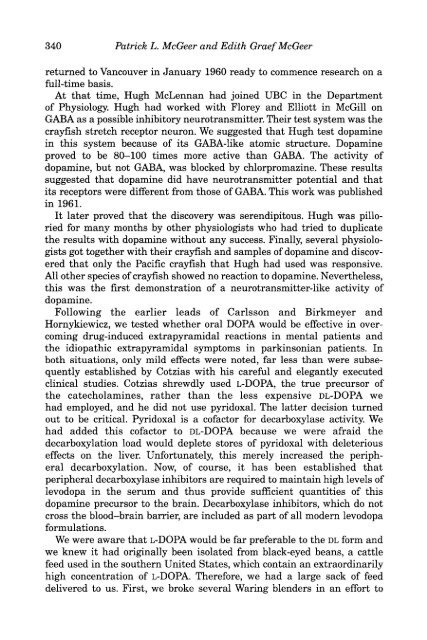Edith Graef McGeer - Society for Neuroscience
Edith Graef McGeer - Society for Neuroscience
Edith Graef McGeer - Society for Neuroscience
You also want an ePaper? Increase the reach of your titles
YUMPU automatically turns print PDFs into web optimized ePapers that Google loves.
340 Patrick L. <strong>McGeer</strong> and <strong>Edith</strong> <strong>Graef</strong><strong>McGeer</strong><br />
returned to Vancouver in January 1960 ready to commence research on a<br />
full-time basis.<br />
At that time, Hugh McLennan had joined UBC in the Department<br />
of Physiology. Hugh had worked with Florey and Elliott in McGill on<br />
GABA as a possible inhibitory neurotransmitter. Their test system was the<br />
crayfish stretch receptor neuron. We suggested that Hugh test dopamine<br />
in this system because of its GABA-like atomic structure. Dopamine<br />
proved to be 80-100 times more active than GABA. The activity of<br />
dopamine, but not GABA, was blocked by chlorpromazine. These results<br />
suggested that dopamine did have neurotransmitter potential and that<br />
its receptors were different from those of GABA. This work was published<br />
in 1961.<br />
It later proved that the discovery was serendipitous. Hugh was pilloried<br />
<strong>for</strong> many months by other physiologists who had tried to duplicate<br />
the results with dopamine without any success. Finally, several physiologists<br />
got together with their crayfish and samples of dopamine and discovered<br />
that only the Pacific crayfish that Hugh had used was responsive.<br />
All other species of crayfish showed no reaction to dopamine. Nevertheless,<br />
this was the first demonstration of a neurotransmitter-like activity of<br />
dopamine.<br />
Following the earlier leads of Carlsson and Birkmeyer and<br />
Hornykiewicz, we tested whether oral DOPA would be effective in overcoming<br />
drug-induced extrapyramidal reactions in mental patients and<br />
the idiopathic extrapyramidal symptoms in parkinsonian patients. In<br />
both situations, only mild effects were noted, far less than were subsequently<br />
established by Cotzias with his careful and elegantly executed<br />
clinical studies. Cotzias shrewdly used L-DOPA, the true precursor of<br />
the catecholamines, rather than the less expensive DL-DOPA we<br />
had employed, and he did not use pyridoxal. The latter decision turned<br />
out to be critical. Pjrridoxal is a cofactor <strong>for</strong> decarboxylase activity. We<br />
had added this cofactor to DL-DOPA because we were afraid the<br />
decarboxylation load would deplete stores of pjo-idoxal with deleterious<br />
effects on the liver. Un<strong>for</strong>tunately, this merely increased the peripheral<br />
decarboxylation. Now, of course, it has been established that<br />
peripheral decarboxylase inhibitors are required to maintain high levels of<br />
levodopa in the serum and thus provide sufficient quantities of this<br />
dopamine precursor to the brain. Decarboxylase inhibitors, which do not<br />
cross the blood-brain barrier, are included as part of all modern levodopa<br />
<strong>for</strong>mulations.<br />
We were aware that L-DOPA would be far preferable to the DL <strong>for</strong>m and<br />
we knew it had originally been isolated from black-eyed beans, a cattle<br />
feed used in the southern United States, which contain an extraordinarily<br />
high concentration of L-DOPA. There<strong>for</strong>e, we had a large sack of feed<br />
delivered to us. First, we broke several Waring blenders in an ef<strong>for</strong>t to











![[Authors]. [Abstract Title]. - Society for Neuroscience](https://img.yumpu.com/8550710/1/190x245/authors-abstract-title-society-for-neuroscience.jpg?quality=85)





